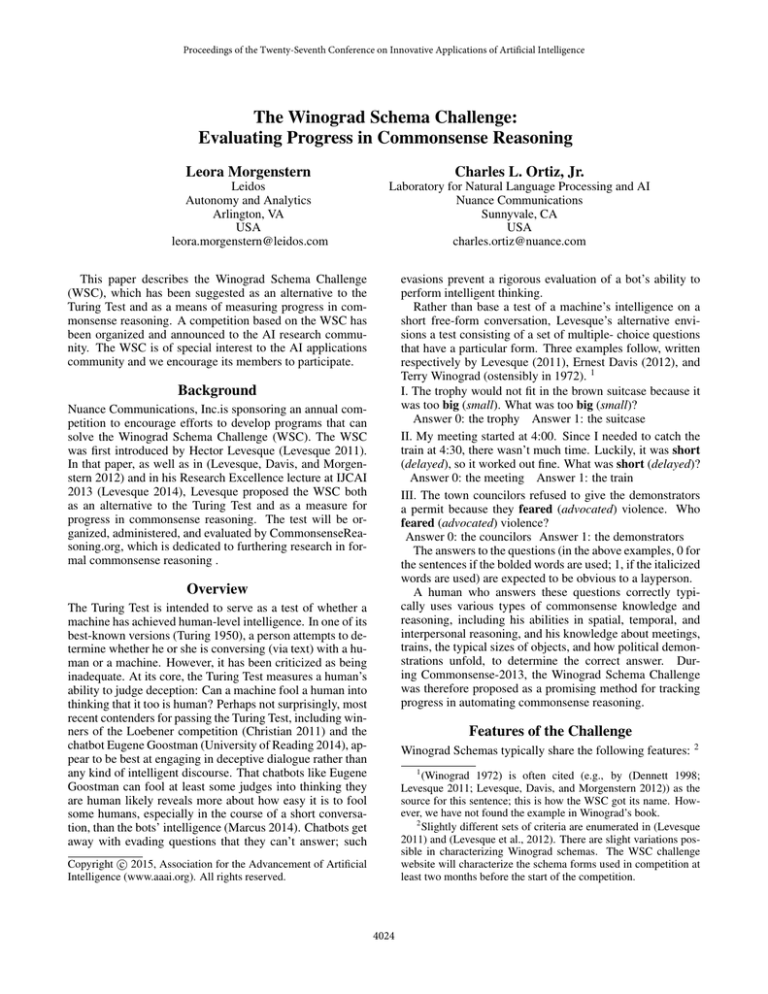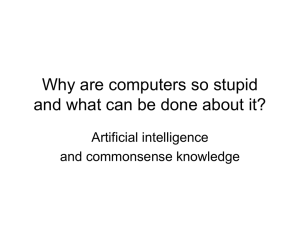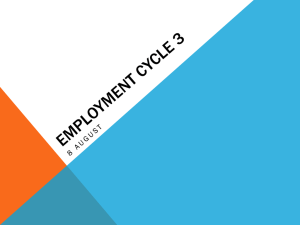
Proceedings of the Twenty-Seventh Conference on Innovative Applications of Artificial Intelligence
The Winograd Schema Challenge:
Evaluating Progress in Commonsense Reasoning
Leora Morgenstern
Leidos
Autonomy and Analytics
Arlington, VA
USA
leora.morgenstern@leidos.com
Charles L. Ortiz, Jr.
Laboratory for Natural Language Processing and AI
Nuance Communications
Sunnyvale, CA
USA
charles.ortiz@nuance.com
evasions prevent a rigorous evaluation of a bot’s ability to
perform intelligent thinking.
Rather than base a test of a machine’s intelligence on a
short free-form conversation, Levesque’s alternative envisions a test consisting of a set of multiple- choice questions
that have a particular form. Three examples follow, written
respectively by Levesque (2011), Ernest Davis (2012), and
Terry Winograd (ostensibly in 1972). 1
I. The trophy would not fit in the brown suitcase because it
was too big (small). What was too big (small)?
Answer 0: the trophy Answer 1: the suitcase
II. My meeting started at 4:00. Since I needed to catch the
train at 4:30, there wasn’t much time. Luckily, it was short
(delayed), so it worked out fine. What was short (delayed)?
Answer 0: the meeting Answer 1: the train
III. The town councilors refused to give the demonstrators
a permit because they feared (advocated) violence. Who
feared (advocated) violence?
Answer 0: the councilors Answer 1: the demonstrators
The answers to the questions (in the above examples, 0 for
the sentences if the bolded words are used; 1, if the italicized
words are used) are expected to be obvious to a layperson.
A human who answers these questions correctly typically uses various types of commonsense knowledge and
reasoning, including his abilities in spatial, temporal, and
interpersonal reasoning, and his knowledge about meetings,
trains, the typical sizes of objects, and how political demonstrations unfold, to determine the correct answer. During Commonsense-2013, the Winograd Schema Challenge
was therefore proposed as a promising method for tracking
progress in automating commonsense reasoning.
This paper describes the Winograd Schema Challenge
(WSC), which has been suggested as an alternative to the
Turing Test and as a means of measuring progress in commonsense reasoning. A competition based on the WSC has
been organized and announced to the AI research community. The WSC is of special interest to the AI applications
community and we encourage its members to participate.
Background
Nuance Communications, Inc.is sponsoring an annual competition to encourage efforts to develop programs that can
solve the Winograd Schema Challenge (WSC). The WSC
was first introduced by Hector Levesque (Levesque 2011).
In that paper, as well as in (Levesque, Davis, and Morgenstern 2012) and in his Research Excellence lecture at IJCAI
2013 (Levesque 2014), Levesque proposed the WSC both
as an alternative to the Turing Test and as a measure for
progress in commonsense reasoning. The test will be organized, administered, and evaluated by CommonsenseReasoning.org, which is dedicated to furthering research in formal commonsense reasoning .
Overview
The Turing Test is intended to serve as a test of whether a
machine has achieved human-level intelligence. In one of its
best-known versions (Turing 1950), a person attempts to determine whether he or she is conversing (via text) with a human or a machine. However, it has been criticized as being
inadequate. At its core, the Turing Test measures a human’s
ability to judge deception: Can a machine fool a human into
thinking that it too is human? Perhaps not surprisingly, most
recent contenders for passing the Turing Test, including winners of the Loebener competition (Christian 2011) and the
chatbot Eugene Goostman (University of Reading 2014), appear to be best at engaging in deceptive dialogue rather than
any kind of intelligent discourse. That chatbots like Eugene
Goostman can fool at least some judges into thinking they
are human likely reveals more about how easy it is to fool
some humans, especially in the course of a short conversation, than the bots’ intelligence (Marcus 2014). Chatbots get
away with evading questions that they can’t answer; such
Features of the Challenge
Winograd Schemas typically share the following features:
2
1
(Winograd 1972) is often cited (e.g., by (Dennett 1998;
Levesque 2011; Levesque, Davis, and Morgenstern 2012)) as the
source for this sentence; this is how the WSC got its name. However, we have not found the example in Winograd’s book.
2
Slightly different sets of criteria are enumerated in (Levesque
2011) and (Levesque et al., 2012). There are slight variations possible in characterizing Winograd schemas. The WSC challenge
website will characterize the schema forms used in competition at
least two months before the start of the competition.
Copyright c 2015, Association for the Advancement of Artificial
Intelligence (www.aaai.org). All rights reserved.
4024
1. Two (sets of) entities, not necessarily people or sentient
beings, are mentioned in the sentences by noun phrases.
2. A pronoun or possessive adjective is used to reference
one party (of the right sort so it can refer to either party).
3. The question involves determining the pronoun’s referent.
4. There is a special word mentioned in the sentence
and possibly the question. When replaced with an alternate word, the answer changes although the question still
makes sense (e.g., in the examples, “big” can be changed to
“small”; “feared” can be changed to “advocated”.)
by a simple trace or explanation that ensures that the solution method has, in fact, demonstrated the requisite advances
in commonsense reasoning. Entrants may adopt both symbolic solution approaches as well as statistical data-driven
approaches. In the latter case, it will be the responsibility of
the entrant to create training data that is consistent with the
examples available in the library described above.
Contest rules
Individuals or teams may enter. If approved by the organizers, a team can include an industry partner. The winner
that meets the baseline for human performance will receive a
grand prize of $25,000. Details of other prizes will be made
available at the WSC website. The current plan is to administer the test on a yearly basis starting in 2015. The first
submission deadline is projected to be October 1, 2015. Additional details, including modifications to these dates, will
appear at at the WSC website. A AAAI 2015 workshop,
“Beyond the Turing Test,” dedicated to exploring alternatives to the Turing Test, will include a discussion on methods for evaluating WSC entries. The 2015 Commonsense
Reasoning Symposium, to be held at the AAAI Spring Symposium at Stanford from March 23-25, 2015, will include a
special session for presentations and discussions on progress
and issues related to the Winograd Schema Challenge.
Consult the WSC website for more information and updates, or send email to leora.morgenstern@leidos.com or
charles.ortiz@nuance.com.
Significance of the WSC
Commonsense reasoning, once considered an esoteric goal
left mostly to theoretical researchers (McCarthy 1986), is
no longer the domain of a select group of researchers. There
have been recent efforts to capture commonsense knowledge
using crowdsourcing methods — e.g., recent work in Freebase and YAGO — and to encode very large commonsense
knowledge bases to provide content for the semantic web.
Since the 1980s, there have been efforts to develop broad
coverage in formal commonsense repositories such as CYC
(Lenat 1995). More recently, Virtual Personal Assistants
(VPAs), which require commonsense knowledge to perform
optimally, are receiving increasing attention. An ability to
measure progress in commonsense reasoning is important to
those engaged in the engineering of AI applications as well
as those involved in basic AI research. The WSC is thus
likely to be of special interest to the IAAA community.
Traditionally, research in the field of commonsense reasoning has been guided by very specific problems collectively identified by the research community as representative of targets for needed research. These have included
problems in temporal reasoning, spatial reasoning, qualitative reasoning about materials, and social reasoning. However, the field has lacked the sort of challenge problems
and competitions that can demonstrate the type of systematic progress found in other communities, such as machine
learning or textual entailment. The WSC is the first attempt
to eliminate this barrier to objectively tracking and measuring ongoing research and progress in the field.
References
Christian, B. 2011. Mind vs. machine. The Atlantic.
Dennett, D. 1998. Brainchildren: Essays on Designing
Minds. Bradford.
Lenat, D. B. 1995. Cyc: A large-scale investment in knowledge infrastructure. CACM 38(11):32–38.
Levesque, H. J.; Davis, E.; and Morgenstern, L. 2012. The
Winograd Schema Challenge. In Proceedings of KR 2012.
Levesque, H. J. 2011. The Winograd Schema Challenge. In
Logical Formalizations of Commonsense Reasoning, 2011
AAAI Spring Symposium, TR SS-11-06,.
Levesque, H. J. 2014. On our best behaviour. Artif. Intell.
212:27–35.
Marcus, G. 2014. What comes after the Turing Test? New
Yorker.
McCarthy, J. 1986. Applications of circumscription to common sense reasoning. Artif. Intell. 28(1):89–116.
Turing, A. M. 1950. Computing machinery and intelligence.
Mind 59:433–460.
University of Reading. 2014. Turing Test success marks
milestone in computing history. June 8, 2014 press release.
Winograd, T. 1972. Understanding Natural Language. Academic Press.
Administration and evaluation of the test
The test, projected to consist of at least 40 Winograd
Schemas, will be administered yearly, with a new set of test
questions supplied each year. Ernest Davis has created more
than 100 sample Winograd Schemas that can be used by participants to test their systems during development3 . This library will be augmented yearly with the previous year’s test.
Further details regarding the establishment of a baseline for human performance for each year’s test, and the
threshold that entries would minimally have to meet to
qualify for prizes, will be available at the WSC website,
http://www.commonsensereasoning.org/winograd. Our
current plans are to grade the test in terms of the number of
Winograd Schemas solved correctly. In addition, we may,
at some future point, require that solutions be accompanied
3
http://www.cs.nyu.edu/davise/papers/WS.html
4025





